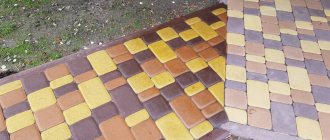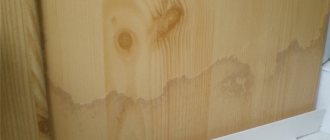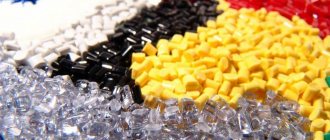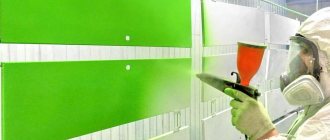Features of the material
Rubber surfaces are destroyed upon contact with an aggressive external environment. The material loses its original qualities and cracks. Long-term exposure to moisture, oxygen and sunlight leads to a decrease in stability and loss of elastic characteristics. In addition to natural factors, gasoline and detergents also have an impact.
Rubber paints are coatings that are used to protect products from the aggressive effects of the natural environment and chemical compounds. Thanks to their viscosity and durability, enamels help maintain the appearance and elasticity of surfaces. After application, the top layer evens out on its own, marks from the roller (brush) and drips quickly disappear.
Painting a flowerpot Source yandex.ua
A high degree of waterproofing increases the water-repellent properties of rubber and increases endurance when in contact with liquids. The protective qualities are not destroyed under the influence of both fresh and salt water. Painted products retain their original appearance for the period specified in the instructions for the product.
Rubber paints are used to protect and decorate surfaces with elastic characteristics. The waterproofing and wear-resistant properties of the material are used for painting:
- garden paths;
- self-leveling floors;
- structures on the shore or in the pool;
- tennis court coverings;
- roofs
Rubber shoe soles can be easily modified or restored with paint. Enamels remove abrasions and noticeable defects on the surface of wardrobe items. The boring design of boots, sneakers or sneakers can be easily transformed by painting. The materials are produced in the traditional white color, but the desired shade is achieved by tinting.
Tire tinting Source sevastopol.izap24.ru
Paints are used for working with tires. The coating protects tires from atmospheric and chemical influences and removes unsightly abrasions and defects. Enamel will transform the banal design of automotive parts into a bright, original design. With the help of coloring it is easy to add mood to rubber flower beds and garden figurines.
Tools and materials
To paint tires you will need:
- dye;
- brush or spray gun;
- mounting tape;
- degreasing liquid;
- emery;
- napkin.
Having collected the necessary materials, it is worth deciding on the coloring technology. The most popular paint scheme today is White Wall: the dye is applied in an even layer to the side surface of the tires. This technology is economical, since less paint is consumed. The working surface of the wheel remains black. The result is a retro style, a combination of black and white, although in general you can choose any color you want. Some are simply limited to painting over the name of the model and brand.
When applying permanent inscriptions, individual letters or patterns on rubber, use the Edding 8050 marker with a solid aluminum body and a hard tip.
This ink is applied in short strokes, as it dries instantly without leaving any odor. These inscriptions last quite a long time.
Types of paints
The choice of finishing material depends on the scope of application and the tasks that the coating must perform. Before painting rubber, you need to study the technical characteristics of the product. There are 3 types of enamels, differing in composition, resistance to impact and appearance.
Rubber
In addition to natural rubber, polymer components and pigmenting substances (whitewash, soot) were added to the paint. White spirit is used as a solvent, so the liquid has a recognizable heavy odor. When painted, a beautiful glossy surface is obtained.
Rubber paint is resistant to temperature changes, sun and humidity, so it is used outdoors. Enamel is not afraid:
- fresh and salt water;
- fuels and lubricants;
- household chemicals.
Among the popular paints for rubber are “KCH-136”. The rubber product is available in white and black. The charcoal look absorbs incoming light so the painted parts appear as dark as possible. To protect elastic products and obtain a smooth surface, apply 2 layers of enamel. When marking, a single application through a stencil is sufficient.
Option for rubber Source perlinapolymers.ru
Varieties of suitable paints
Manufacturers of paints and varnishes produce various paints for painting rubber products and restoring the color of car tires. In any case, the coloring composition will need to be applied to the rubber surface prepared for painting.
Types of coatings for rubber products:
- Tire ink is a liquid for painting tires with a silicone composition. They come in matte and glossy.
- Pros - the ink gives the tire a rich black color, the coating is easy to wash and does not wear off, and protects against water and chemicals.
- Disadvantages - short service life (several months), the ink strongly eats into the metal (it is recommended to first seal the surface not intended for painting).
- Paint for tires KCH-136. Contains rubber. It comes in black, white, silver.
- Pros - excellent adhesion to rubber, a perfectly smooth coating protects products from water, ultraviolet radiation, and adverse weather conditions, lasts up to 4 years.
- Disadvantages: toxicity; white spirit is used for dilution.
- Rubber paint "REZEL+" to protect the surface from water. This paintwork material contains latex and acrylic resin. "REZEL+" is water-based and is used for painting swimming pools, facades, and paths.
- Pros - available in various colors, after application it creates an elastic and durable film that protects from moisture.
- Disadvantages - does not tolerate sub-zero temperatures well, requires surface preparation for painting.
- Noris stamp paint for rubber. Available in black and other colors.
- Pros: it gives rubber a rich color, dries quickly, does not crack, and protects from moisture.
- Cons: It wears off over time.
- “Liquid rubber” (acrylic). Available in different colors. It comes in matte and glossy.
- Pros - creates a strong elastic film on the surface, “merges” with rubber, protects from moisture.
- Cons: high price, high consumption.
- White Tire Paint. Used for painting the side surfaces of tires and applying letters.
- Pros: excellent adhesion to rubber, dries quickly, creates an elastic film.
- Cons: gets dirty quickly.
- RUNWAY aerosol liquid rubber. This is a spray paint, a coloring composition based on synthetic rubber.
- Pros - after spraying, it creates an elastic film, protects the surface from abrasion and moisture.
- Cons: high price, high consumption.
- Paint tire markers. Available in various colors (white, silver, yellow).
- Pros: ready to use, they help write clearly visible letters on the side of tires.
- Cons: high price, fast consumption.
- Rubber paint I LIKE (spray). Completely ready-made coloring agent for painting tires (in different colors).
- Pros - creates an elastic, durable coating on the surface, protects from moisture.
- Cons: high price, high consumption.
- KUDO liquid rubber (spray). Aerosol products that create an elastic film on the surface. Available in different colors.
- Pros - additionally protects the surface from moisture.
- Cons: high price, high consumption.
See also
How to choose the best primer for walls under wallpaper and rules for applying compositions
How to use
The decorative and protective properties of enamel depend on the application technique. Before painting rubber, you need to properly prepare the surface. Painting rubberized elements is divided into 3 stages.
Cleansing
In order for the enamel to stick well, you need to remove the old coating. Using soapy water and baking soda, carefully remove any remaining paint using a spatula. Rust is removed with washing powder. After the procedure, rinse generously with clean liquid, washing away dust and dirt.
How to wash a tire Source yandex.ua
Before applying paint, the rubber is degreased with white spirit. If there are stains from diesel fuel on the surface, alcohol will help remove the stains. A piece of cloth is soaked in the liquid, applied tightly to the oily areas and the dirt is carefully removed.
Mode of application
After we figured out what exactly rubber is painted with, it’s time to find out how this happens. Indeed, to significantly extend the service life of a painted product, you should not only know, but also strictly follow certain rules:
- a prerequisite is thorough cleaning of the surface being treated from any traces of dirt;
- the next step is degreasing using white spirit, alcohol, or another solvent;
- The coating itself should be applied in 1-2 layers, using a brush, roller, spray gun, or simply dipping the part.
How to paint rubber black
To paint your tires black, a car enthusiast does not necessarily have to go to a service station, since after purchase the paint is almost completely ready for use, and any average person with one hour of time can carry out the entire procedure right in his garage, following the step-by-step instructions below instructions:
- Wash the car thoroughly with special products, paying special attention to the wheels.
- Using a rag soaked in a weak solvent, it is necessary to treat the entire surface of the tire, removing from it all oil, bitumen and other deposits remaining after use. As a result of this procedure, the entire tire should have a uniform matte shade.
- The important point is that the wheel must be inflated to optimal parameters while applying the pigment. Despite the elasticity of the material, it is better for it to be under short-term tension than under constant tension, otherwise the thickness of the pigment will decrease sharply if the wheel has to be inflated after painting, or, conversely, the layer will become covered with folds when there is excessive pressure inside the tire.
You might be interested in this About tires for Niva
Acrylic paint for tires
- The entire surface to be painted is sanded with fine sandpaper until the deepest contaminants are removed and a tire layer appears, which helps to increase adhesion when applying the substance.
- After treatment with abrasive, the wheel is degreased and dried again, as a result of which it is completely ready for treatment with a coloring composition.
- Metal discs are carefully sealed with masking tape so that particles of persistent pigment do not accidentally fall on them, ruining the appearance of the entire wheel.
- The can of paint must be shaken, after which with one press the layer is evenly applied over the entire surface of the rubber product until completely painted.
- Next, you need to wait for the composition to dry, which will take from 30 minutes to 1.5 hours, depending on the components of the pigment.
- The procedure is repeated 1-2 more times until an even layer without streaks and unpainted areas is achieved.
Important!
If the entire painting operation is carried out correctly, the rubber will remain in this condition for at least 1-2 seasons, regardless of the environmental impact on it. When painting, it is necessary to observe the standard temperature regime of 10 degrees Celsius and above, and also to prevent moisture from getting on the rubber.
Professional tire painting
Methods for restoring the color of tires without using paint
Blackening of tires
The process of blackening tires involves coating the tire with a special liquid - ink. You can buy such a product at the car market or in special stores. The range of factory inks is represented by two types of blackening mixtures:
In addition to improving the appearance of tires, inks protect rubber from the external negative effects of sunlight, water, chemicals, and so on. The protective function of these substances is possible due to the creation of a thin film on the surface of the tire.
How to properly apply paint to rubber
All work is divided into two stages. The first is the preparation of materials and the surface itself. The second is the actual painting work.
But to achieve the best effect when painting rubber, there are several simple rules that any uninitiated person can follow. Compliance with them will ensure reliability, high quality of the work done, and will undoubtedly breathe “new life” into the product.
It is most convenient to express these rules in the form of instructions:
How to paint rubber?
When painting tires, the partial painting method is used, since the back of the tire is simply not visible, but the working part is in contact with the road. It should be understood that a car tire is subjected to alternating loads when driving many times. Tires are also exposed to very aggressive environmental and artificial environments. Therefore, painting car tires differs from the usual painting of the body.
The most popular color for tire painting among tuning companies is white. This color has become widespread when decorating tires due to its low cost. It is best to paint wider, high profile tires. Painting low-profile tires is quite rare. It is characterized by tinting certain areas or highlighting the brand inscription.
In automobile stores you can find enamels for painting car tires or sealants. For partial painting, for example, highlighting the manufacturer's company, a marker with paint is suitable.
Tire paint must have three main properties:
- high adhesion to rubber;
- high elasticity after drying;
- wear resistance.
These properties are possessed, first of all, by special paints based on latex, rubber or acrylic. Rubber and latex paints have the greatest strength and elasticity.
But regular wall paints, such as latex, are not suitable for painting tires. The latex content in them is very small, and their elasticity is low. When the tire is beaded, the inscriptions using such paints will most likely crack.
What kind of paint is needed for tires
When deciding what paint to use on a tire, you should familiarize yourself with the features of the offered dyes. Rubber and polyurethane based compounds are used. The substances retain sufficient plasticity after drying. Tire paint must withstand all the elements. As a last resort, buy any one marked “suitable for rubber.”
Such paint can be produced in the following forms:
- Aerosol can;
- Bucket or jar;
- Marker.
You will have to make the choice in what form to purchase paint yourself, based on your own convenience. For example, it is easier to make an inscription with a marker, and it is easier to completely paint it with a brush from a can or a spray can.
We list several paint options found in stores.
- KCH-136. Created on the basis of natural rubber, the composition contains polymers. Available in white only.
- Rezel+. Contains latex and acrylic. May be of different colors. Available packaged in cans or jars.
- White Tire Pain. Produced on a polymer basis. Available in all types of packaging.
What paints to use
You can use any product to paint tires:
- Special compounds intended for application to rubber surfaces. Such products are expensive, but are an ideal option for tinting a future flower bed due to their ability to hide unevenness and cracks, as well as protect painted surfaces from exposure to low temperatures.
- Acrylic paints. Applied to a previously degreased tire, they last a very long time and do not crack during use.
- Water-based compositions. This option is suitable for outdoor work, the coating fits perfectly, but there is a significant drawback - over time it is subject to fading.
Painting an old wheel with spray paint from a can
- Aerosols. Such products are very convenient to use; the tone can penetrate even the most difficult to reach areas. Using aerosol cans, smooth transitions from one shade to another are created.
- Oil based. They are characterized by good adhesion to rubber products and can last a long time.
- Automotive trains. The paints dry quickly, last a long time, and are an excellent option for use as a base layer.
- Nitro enamels. Such substances dry in a short period of time, do not fade in the bright sun, and adhere well to rubber.
To paint small details, it is better to use special paints that are resistant to environmental factors. Usually, art stores sell ready-made sets with coatings of different colors, packaged in small jars for convenience.
What is tire paint for wheels?
Rubber paint is a pigment with a complex chemical composition that adheres to the tire, has elasticity and takes part in the deformation of the product, and also gives the wheel an original appearance. Materials such as latex, antifreeze, coalescent and other complex compounds provide the substance with the following properties after application:
Painted tire
Stamp paint for rubber











